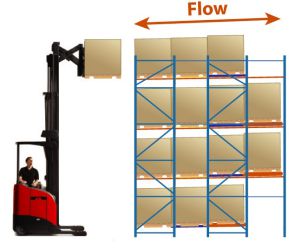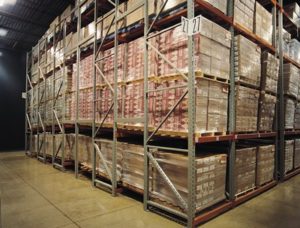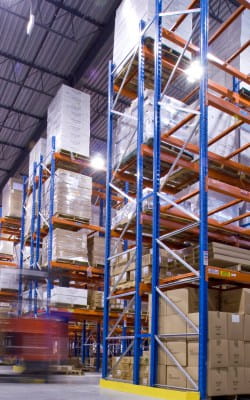-

Push Back Racking
Push-back racking has enjoyed rapid growth in popularity recently due to offering similar space savings as drive-in, with typically 3 to 5 times greater selectivity. This growth has been spurred by marketing trends such as rapid increases in number of SKUs, mass customization, and more rapid product obsolescence.
Each level in a push-back system holds a series of nested rolling carts, operating in a lane which slopes upward away from the pick face. -
To load the lane, the first pallet loaded in the lane is loaded onto the top cart. To load the next pallet in the lane, the lift truck operator lines up in front of the first pallet and pushes against it, causing the first pallet to roll back away from the pick face, and exposing the next cart, which the second pallet can be lowered onto, once it’s in position. The process is repeated until the lane is full. To empty the lane, the operator slowly removes the last pallet in, and the others roll back forward, down to the pick face. Similarly, the process continues until the lane is empty.
Operational Considerations
-

Key Benefits
- High densities – three and four deep systems are common, which allows blocks of 6 or 8 deep, with back to back rows. Depths of up to 6 deep are also available, at higher costs.
- Improved selectivity over Drive-In, which Push-Back often replaces.
- Efficiency vs. Drive-In – trucks do not need to drive into rack loads come to them at the pick face.
- Less rack. Truck and product damage vs. Drive-In- with no trucks driving inside rack.
- High densities – three and four deep systems are common, which allows blocks of 6 or 8 deep, with back to back rows. Depths of up to 6 deep are also available, at higher costs.
-
Advantages
Advantages Over Single Selective Racking
- - In a typical three deep, back to back Push Back system, space savings would amount to around 40% vs. Single Selective Rack.
- - Converting an existing space from Single Selective to Push Back would accommodate an increase of about 60% in pallets stored.
- - Over-head Push-Back (loaded and unloaded from replenishment aisle in rear) ensures optimal use of vertical space above floor level Pallet Flow picking system.
- - In a typical three deep, back to back Push Back system, space savings would amount to around 40% vs. Single Selective Rack.
-
More Information
There are a number of particular factors to satisfy before making a push-back purchase:
- Carts should be linked to avoid “runaway carts”.
- Pallet quality must be considered.
- Slope is critical for both safety and operating performance.
- The system must be designed for dynamic loads – in simple terms, that means it needs to be more robust than if pallets were static. This also means that Push-Back requires more complex engineering. One sub-standard component, and your system may not flow! Unfortunately, we’ve seen customers victimized this way.
- “Vertical Profile” of the nested carts may be critical, if there is a height restriction in the building.
- Push-Back systems are starting to be misapplied, the same as Drive-In systems once were. You need to make sure that you are storing the right cross-section of your SKU’s in Push-Back systems.
- Carts should be linked to avoid “runaway carts”.
<center>Contact Our Push Back Racking Specialist Today</center>
Fill out the form below to get a FREE no obligation quote from our Racking Systems Specialists.



